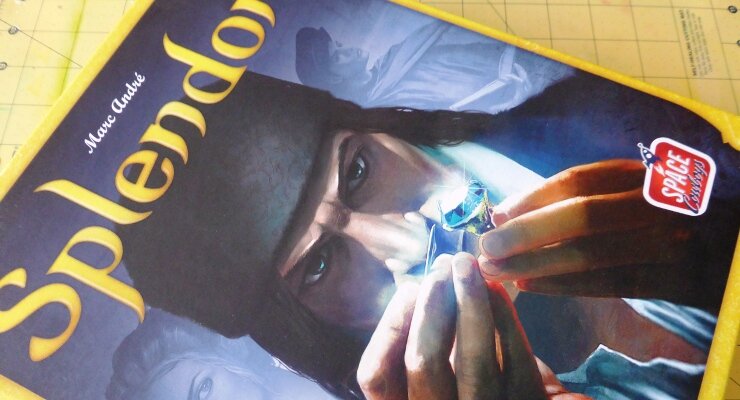
Splendor is an entertaining, abstract game where 2 – 4 players race to the most points.
A lot of descriptions – on Amazon for example – describe the game as “addictive”. I don’t think I fully agree, but Splendor is a great way to spend 30 minutes, and the “puzzle” to collect the right combination of cards is diverse enough to give the game great replay value.
As a wealthy Renaissance merchant, acquire mines and transportation, hire artisans and woo the nobility. Create the most fantastic jewelry to become the best-known merchant of them all! Players will acquire precious stones to trade them for development cards. Use development cards to acquire more gem stones. Use your gems and gold to create the most fantastic jewelry, and appeal to the nobles to gain the prestige you need to win.
#1 – Splendor: The Theme

Let’s be honest, nobody will buy Splendor for the theme. It’s an abstract game, in a way.
The whole gemstone-schtick works, because it chimes with the “different-colour”-mechanic of the game itself. However, nobody is going to feel like a “Renaissance merchant” playing splendor though. It could’ve worked with any other time that allows “colours”.
#2 – Splendor: The Components

I talked about the components in more detail. They are clearly one of the highlights of this game (which isn’t cheap, to be fair).
The artwork and cards are well designed. The “style” of the artwork, for my taste, is a bit generic, but one cannot fault the design for its clear functionality.
Moreover, the true star are the poker chips, which make playing this game so much fun than it would be with wooden cubes, meeples, etc… Sitting around the table, having the chips “click” in your hands, while you ponder your next move just adds so much flair.
#3 – Splendor: The Game Itself

Splendor is a simple, abstract game (even though it took me quite a few words to explain it).
In many ways, I feel the game play is not at all unlike a puzzle, as players (or at least) me try to find the right combination of chips and cards to get to those magical 15 (prestige) points.
One (minor) complaint I would add is that the interaction between players is fairly minimal. In the game, other players are the clock you race against, and the reasons the gemstone-chips are scarce. Beyond that, most players “play” by their own.
In theory, there could be a bit of competition, for example by hording a card another player is trying to get. In practice, I rarely found this to be a game-winning strategy. Usually there are more than enough alternatives and options.
#4 – Thoughts?
Splendor is an interesting game. The game-play is simple, even deceptively so, but it also shows how much variety and fun you can get out of a simple game-mechanic, if done right.
Splendor isn’t a massively complex, or very long game, but it fills the “let’s kill 30 minutes”-slot perfectly. Unlike Coup, it isn’t so short that the games feel meaningless either.
Virtually every game I played, and especially those games I lost, I found my self wanting to play another round, a re-match and have a go at it again.
Z.







